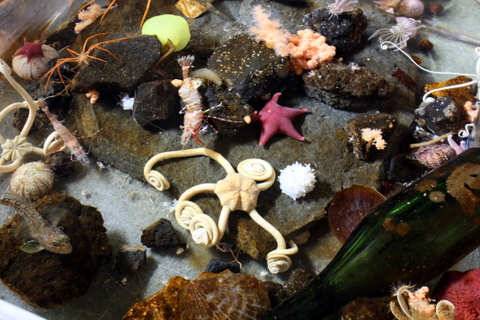A Fish Tail
Dissostichus mawsoni?! What’s that? It’s also known as the Antarctic Toothfish, Antarctic Cod, and Chilean Sea Bass. It can grow to be up to six feet long and weigh over 300 pounds . They can live for 50 years or longer. This fish is also being taken from Antarctic waters, especially the Ross Sea area where I am, by commercial fishermen. Very little is known about this fish, but there are serious concerns that it is being fished faster than it can reproduce.

Several different researchers are studying this fish here at McMurdo Station. To do this the research teams literally “go fishing”. Out on the sea ice around McMurdo there are many small orange huts that are mounted on skis. These are fish huts. In their floor is a hole, and under the floor there is a hole in the ice through which the research teams let a line down and try to catch the fish. Many of the fish are simply caught, measured and weighed, then released back into the ocean. Some are kept and brought to the aquarium here at McMurdo Station to study.

Right now there are several very large Antarctic Toothfish at McMurdo. I was down in the aquarium today taking pictures of these fascinating fish. As you can see from the pictures, they look almost prehistoric. The picture of the skull shows you why they are called toothfish.

I wondered what their preferred food is, because as I stood there taking these pictures, the fish kept looking at me – maybe to decide if I was worth eating as a snack!

Since I know almost nothing about these fish, I took a look at www. http://www.lastocean.org/Commercial-Fishing/About-Toothfish-/All-about-Antarctic-toothfish-__I.2445 to learn about them. By coincidence, I had seen a video here at McMurdo a few weeks ago that was produced by the Last Ocean group to help people understand some of the issues related to ocean fishing and exploitation of this fish.
The toothfish is a major predator in the Ross Sea, eating other smaller fish and squid. It is also one of the largest, growing to over in weight and over long. This fish is also important food for Weddell Seals, sperm whales, and one species of killer whale.

One interesting fact about these fish is that their blood contains special proteins that act like anti-freeze to keep the blood from freezing. In spite of the work that has been done on them because of their unusual blood, very little is known about their life habits and where they live. It is known that they can live for up to 50 years and that they grow slowly. They are believed to reach maturity in 13 to 17 years.

Most of the fish that are known to exist are found in the Ross Sea, which is the part of the ocean that surrounds Ross Island where McMurdo Station is. They live in water that is from 900 to over 6000 feet deep. Most fish use an air bladder (sack) to help them stay at a certain depth, but the toothfish does not have an air bladder. Instead it uses fats (lipids) in its body to control its depth. These fats make it very tasty and it is a popular human food. This last fact is what is causing an increase in fishing and a decrease in the number of toothfish in the ocean.
One of the big mysteries about this fish is that no one knows for sure where it reproduces. Small (juvenile) fish have been found in many areas, but never in the Ross Sea. This has led researcher to hypothesize that the fish migrate to areas along the Pacific-Antarctic Ridge system to spawn. It is believed that the fish release their eggs into the ocean and ocean currents then bring the eggs back to the Antarctic Ocean and Ross Sea where the fish mature. This is one of the areas of research being done on these fish.
If you’ve ever been to a restaurant or fish market and seen a fish called “Chilean Sea Bass”, it is the Antarctic Toothfish. It’s delicious to eat, but unfortunately because it is so good, it is being fished very aggressively. Fishing in the Ross Sea started in 1996 and since then an international agreement has been reached that allows fishermen to catch 3000 tonnes (6,600,000 pounds) of toothfish per year. If the average fish weights 60 pounds, that is 10,000 fish. There is great concern that this is many, many more fish than should be caught. If more fish are caught than reproduce, in a short time the number of fish could drop to the point that they cannot produce enough young fish to survive. Man has already overfished a huge number of different fish species including the North Atlantic Cod, Tuna and possibly sharks.
For more information on the toothfish go to http://www.lastocean.org/
For information on sustainable fisheries, the Monterey Bay Aquarium has some excellent information at http://www.montereybayaquarium.org/cr/seafoodwatch.aspx?c=dd


Comments